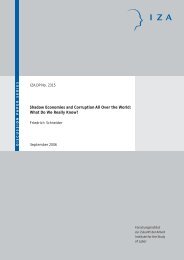The Great Recession of 2008-2009: Causes ... - Index of - IZA
The Great Recession of 2008-2009: Causes ... - Index of - IZA
The Great Recession of 2008-2009: Causes ... - Index of - IZA
- TAGS
- recession
- index
- ftp.iza.org
You also want an ePaper? Increase the reach of your titles
YUMPU automatically turns print PDFs into web optimized ePapers that Google loves.
output gap leading to higher fiscal expansion)<br />
*Initial conditions constrain size <strong>of</strong> fiscal<br />
expansion<br />
OECD OECD economies 3.4 *Although size appears large, impact not<br />
significant enough to <strong>of</strong>fset output gap<br />
*Diversified approach, but evidence is that<br />
‘spending multipliers’ bigger than ‘tax<br />
multipliers’<br />
* Negative relationship between ‘automatic<br />
stabilizers’ and size <strong>of</strong> fiscal expansion<br />
Source: ILO/IILS (<strong>2009</strong>), IMF (<strong>2009</strong>d, e), Khatiwada (<strong>2009</strong>), OECD (<strong>2009</strong>), and Prasad and Sorkin (<strong>2009</strong>).<br />
4.2 Labour market and social policies as part <strong>of</strong> the response to the crisis<br />
In addition to macroeconomic policy, specific labour market measures also have a role in<br />
mitigating the impact <strong>of</strong> the crisis on workers, helping reduce the lag between economic<br />
growth and job creation, as well as preventing the risk <strong>of</strong> unemployment persistence, longterm<br />
unemployment and human capital deterioration. Formulating appropriate policy<br />
interventions requires recognizing how the labour market adjusts as a result <strong>of</strong> the credit<br />
squeeze and collapse in aggregate demand, which is discussed further in section 3. In this<br />
respect, the degree and form <strong>of</strong> adjustment will depend on the magnitude <strong>of</strong> the crisis in their<br />
country and region, and the level <strong>of</strong> labour market flexibility. <strong>The</strong> latter is influenced by the<br />
institutional arrangements in the labour market (such as wage setting institutions,<br />
unionization, employment protection legislation, etc.).<br />
In light <strong>of</strong> the various labour market adjustment mechanisms discussed above (section 3.2),<br />
the labour market policy response to the crisis has centred around four main areas:<br />
maintaining and increasing labour demand; improving the match between demand and<br />
supply; providing income support; and targeting <strong>of</strong> vulnerable groups. Drawing on the<br />
findings <strong>of</strong> a range <strong>of</strong> recent surveys on the policy response to the global financial crisis <strong>of</strong><br />
<strong>2008</strong>-<strong>2009</strong>, a large number <strong>of</strong> high-income countries have utilized policy measures that<br />
address these different goals (Figure 11). 41 <strong>The</strong> most commonly used intervention in highincome<br />
countries is training for both those threatened by lay<strong>of</strong>fs and the unemployed<br />
(including work experience and apprenticeship initiatives) (27 countries), followed by work<br />
sharing (24 countries), increased resources for public employment services, including job<br />
41 See Cazes et al. (<strong>2009</strong>). For similar analysis, see ILO (<strong>2009</strong>a) and OECD (<strong>2009</strong>).<br />
43
















